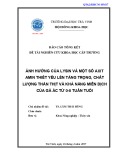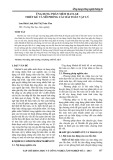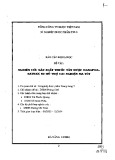
Implementation
Science
Brouwers et al. Implementation Science 2010, 5:29
http://www.implementationscience.com/content/5/1/29
Open Access
STUDY PROTOCOL
BioMed Central
© 2010 Brouwers et al; licensee BioMed Central Ltd. This is an Open Access article distributed under the terms of the Creative Commons
Attribution License (http://creativecommons.org/licenses/by/2.0), which permits unrestricted use, distribution, and reproduction in
any medium, provided the original work is properly cited.
Study protocol
A randomized trial to evaluate e-learning
interventions designed to improve learner's
performance, satisfaction, and self-efficacy with
the AGREE II
Melissa C Brouwers*
1
, Julie Makarski
2
and Anthony J Levinson
3
Abstract
Background: Practice guidelines (PGs) are systematically developed statements intended to assist in patient,
practitioner, and policy decisions. The AGREE II is the revised and updated standard tool for guideline development,
reporting and evaluation. It is comprised of 23 items and a user's Manual. The AGREE II is ready for use.
Objectives: To develop, execute, and evaluate the impact of two internet-based educational interventions designed
to accelerate the capacity of stakeholders to use the AGREE II: a multimedia didactic tutorial with a virtual coach, and a
higher intensity training program including both the didactic tutorial and an interactive practice exercise component.
Methods: Participants (clinicians, developers, and policy makers) will be randomly assigned to one of three conditions.
Condition one, didactic tutorial -- participants will go through the on-line AGREE II tutorial supported by a virtual coach
and review of the AGREE II prior to appraising the test PG. Condition two, tutorial + practice -- following the multimedia
didactic tutorial with a virtual coach, participants will review the on-line AGREE II independently and use it to appraise
a practice PG. Upon entering their AGREE II score for the practice PG, participants will be given immediate feedback on
how their score compares to expert norms. If their score falls outside a predefined range, the participant will receive a
series of hints to guide the appraisal process. Participants will receive an overall summary of their performance
appraising the PG compared to expert norms. Condition three, control arm -- participants will receive a PDF copy of the
AGREE II for review and to appraise the test PG on-line. All participants will then rate one of ten test PGs with the AGREE
II. The outcomes of interest are learners' performance, satisfaction, self-efficacy, mental effort, and time-on-task;
comparisons will be made across each of the test groups.
Discussion: Our research will test innovative educational interventions of various intensities and instructional design
to promote the adoption of AGREE II and to identify those strategies that are most effective for training. The results will
facilitate international capacity to apply the AGREE II accurately and with confidence and to enhance the overall
guideline enterprise.
Introduction
Evidence-based practice guidelines (PGs) are systemati-
cally developed statements aimed at assisting clinicians
and patients to make decisions about appropriate health
care for specific clinical circumstances [1] and to inform
decisions made by health care policy makers and clinical
managers [2,3]. In systematic reviews, guidelines have
been shown to have a modest impact on behavior [4].
However, the potential benefits of their application are
only as good as the guidelines themselves [5-7]. To enable
differentiation between PGs of varying quality and to
advance the PG enterprise, the AGREE (Appraisal of
Guideline Research and Evaluation) collaboration was
established to facilitate the development of a generic
instrument to assess the process of PG development.
Using rigorous methodologies of measurement construc-
tion [8], the AGREE collaboration produced the original
* Correspondence: mbrouwer@mcmaster.ca
1 McMaster University, Department of Oncology and Department of Clinical
Epidemiology, McMaster University, Hamilton, Ontario, Canada
Full list of author information is available at the end of the article

Brouwers et al. Implementation Science 2010, 5:29
http://www.implementationscience.com/content/5/1/29
Page 2 of 6
AGREE Instrument released in 2003 [[9]; http://
www.agreetrust.org].
As with any new development tool, it was recognized
that on-going methodological refinement of the AGREE
instrument was required. This led to the establishment of
a second international group of researchers, the AGREE
Next Steps Consortium. The consortium undertook a
program of research with the objectives of strengthening
the measurement properties of the instrument, refining
some of the items, systematically exploring its utility
across stakeholders, and improving the supporting docu-
mentation to help users implement the instrument with
more confidence. The results of these efforts are the
AGREE II [[10-12]; http://www.agreetrust.org]. The
AGREE II consists of 23 items grouped into the six origi-
nal domains: scope and purpose, stakeholder involve-
ment, rigour of development, clarity of presentation,
applicability, and editorial independence. Compared to
the original AGREE instrument, approximately one-half
of the items have been modified, domain structures have
been altered, and an extensive restructuring of the sup-
porting documentation, the user's manual, was under-
taken. A new seven-point response scale has also been
introduced, replacing the original four-point scale. The
AGREE II was released at the Guidelines International
Network Fall 2009 Colloquium and is ready for use.
Diffusion of the original instrument attests to its wide
coverage and acceptance but also highlights the complex-
ity of successfully facilitating the uptake of the revised
version. In conducting an analysis of the ISI Web of Sci-
ence (unpublished), we found 139 citations of the original
AGREE paper between its publication in 2003 and
December 2008, with numbers increasing every year.
Lead authors represented 23 different countries and pub-
lications appeared in 95 different peer-reviewed journals
-- both specialist and generalist publications. The cita-
tions represented a wide spectrum of diseases and disci-
plines, including cancer, cardiology, diabetes, dentistry,
psychiatry, and occupational medicine.
We anticipate the demand for the AGREE II will be as
high. We are promoting the AGREE II to a broad constit-
uency and the dissemination plan is international in
focus. The target audience includes a variety of stake-
holder groups (clinicians, researchers, policy makers, PG
developers, system leaders) and, within groups, a range of
experience with PGs and the AGREE enterprise (i.e.,
from novice to expert). Thus, the internet is a key
medium for our knowledge translation and exchange
(KTE) strategy. However, dissemination alone, even with
a primed and interested audience, is not sufficient to
maximize the application and use of the AGREE II.
Thus, we wish to explore educational interventions and
leverage technical platforms to accelerate the process. E-
learning (internet-based training) provides a potentially
effective, standardized, and cost-efficient model for train-
ing in the use of AGREE II. A recent meta-analysis and
systematic review of 201 studies by Cook et al. showed
large effect sizes for internet-based instruction (clinical
and methodological content areas) with health-profes-
sion learners [13]. Most of the studies considered knowl-
edge outcomes and found evidence of a substantial
benefit. Those studies reporting a skills outcome, how-
ever, also found a very large effect size for e-learning
interventions. The findings held true in subgroup analy-
ses comparing different learner types, contexts, topics
and outcomes. Thus, e-learning appears to be a promis-
ing, effective, practical, and efficient KTE technique to
consider in our context, and we will test two interven-
tions aimed at facilitating the application of the AGREE
II.
Key evidence-based principles exist that underpin the
development of technical training and multimedia learn-
ing to which we will adhere. The Instructional Systems
Development framework, including the ADDIE (analysis,
design, development, implementation, and evaluation)
model of instructional development will serve as our
approach in the design and refinement stages of our
intervention [14]. The work by Clark et al. will inform the
structure and specific content types that will be incorpo-
rated [15-18]. Narration choices, contiguous labeling, and
the use of graphics will follow the principles of multime-
dia learning [17,19]. Principles derived from cognitive
load theory will also be taken into consideration in the
design of the educational interventions [16,20].
In a meta-analysis and systematic review of instruc-
tional design variations in web-based learning, Cook et
al. found that increased interactivity, practice exercises,
repetition, and feedback were associated with improved
learning outcomes [13]. However, while the evidence base
underpinning the efficacy and design principles of inter-
net-based training materials are well established, there
remain questions regarding the optimal application of
these principles for particular interventions. For example,
both worked examples (demonstrations) and practice
exercises with feedback have been shown to be effective
training methods [17]. Yet some evidence suggests that
novice learners may benefit more from worked examples,
and expert learners more from practice [16,18]. More-
over, many recommended instructional design interven-
tions such as interactivity, practice exercises, or
repetition may take longer to develop, and also take up
more of the learners' time, potentially leading to less effi-
cient training. In developing an optimal on-line training
intervention for the AGREE II, we also aim to study some
of these key instructional design variables and time-on-
task.
Our research objectives are: to design and refine an on-
line AGREE II training program comprised of a multime-

Brouwers et al. Implementation Science 2010, 5:29
http://www.implementationscience.com/content/5/1/29
Page 3 of 6
dia didactic overview tutorial; to design and refine an on-
line, interactive AGREE II training program, comprised
of the overview tutorial plus an interactive practice exer-
cise with feedback module; to compare the two interven-
tions against a standard control (access to static PDF
version of the user's manual) and to evaluate learners'
performance (distance function to experts, pass/fail rate),
satisfaction, self-efficacy, mental effort, and time-on-task
with the AGREE II; and to compare how previous experi-
ence with PGs and the AGREE II influence these effects.
Two core research questions are considered: Compared
to the passive learning of the materials, does an on-line
training program, with or without a practice exercise,
improve learners' performance and increase learners' sat-
isfaction and self-efficacy/-confidence with the AGREE II
and AGREE II user's manual? Are there differences across
the outcome measures between the two educational
intervention groups? Are these differences influenced by
learners' experiences with PGs or the AGREE II?
Methods
This study is funded by the Canadian Institutes of Health
Research and has received ethics approval from the Ham-
ilton Health Sciences/Faculty of Health Sciences
Research Board Ethics approval (REB #09-398; Hamilton,
Ontario, Canada).
Study design
A single factorial design with three levels of educational
intervention is proposed. The levels are:
Didactic tutorial
Participants assigned to this training program condition
will receive access to a password-protected website. They
will receive a brief (five-minute) multimedia didactic
tutorial with an overview of the AGREE II conducted by a
'virtual coach' or avatar. The tutorial is under program
control with forced linear progression in sequence with
the screens advancing automatically, although the partici-
pant may pause the tutorial at any time. Following the
tutorial, the participant is granted access to the AGREE II
user's manual and is instructed to review the manual
before proceeding to the test PG.
Tutorial with practice exercise
Participants assigned to this training condition will
receive access to a password-protected website. They will
be provided with the same didactic tutorial as the previ-
ous condition before being granted access to the user's
manual as above. They will then be presented with a
practice PG to appraise using the AGREE II training tool
and will be asked to answer each AGREE II item in turn.
Upon entering their AGREE II score, participants will be
given immediate feedback on how their score compares
to the mean of four experts. If their score falls outside a
predefined range, participants will receive formative
feedback to guide the appraisal process. At the conclusion
of their review, participants will receive an overall sum-
mary of their performance in appraising the practice PG
compared to expert norms before proceeding to the test
PG.
Passive learning
Participants assigned to the passive learning will receive
static PDF copies of the AGREE II for review before pro-
ceeding to the test PG. Passive learning participants will
serve as our control group.
Sample Size
The primary analysis involves one-way analysis of vari-
ance (ANOVA) comparisons of the AGREE II perfor-
mance score profiles of the three study group participants
with the performance score profiles of AGREE II experts.
This will be measured by the sum of squared deviations
(SS) distance function. To avoid untenable assumptions
regarding the relative size of the intermediate group
mean, we simplify calculations by focusing on the power
for testing differences in mean SS between the passive
learning condition and either of the intervention groups,
which represents a strong a priori comparison of the least
and most effective interventions. Previous research has
found the effect size of e-learning in comparison to no
intervention to be large ranging from 1.13 to 1.50 [16-18].
Our intent is to estimate a more conservative effect size.
Thus, with 20 participants per group, a one-sided test will
have at least 80% power to detect an advantage of as little
as ± 0.79 standard deviations for either of the interven-
tion groups compared to the passive learning group. To
account for potential missing data, we will include up to
25 participants per group for a total of 75 participants in
the study.
Materials and instruments
Guidelines
Eleven PGs have been selected from the National Guide-
lines Clearinghouse http://www.guidelines.gov, CMA
Infobase http://www.cma.ca/index.cfm/ci_id/54316/
la_id/1.htm, and Guidelines International Network http:/
/www.g-i-n.net/ directories for this study. One PG will
serve as the practice PG for those assigned to the tutorial
+ practice exercise condition, and ten will serve as the test
PGs in the study. Criteria for the PG search included:
English-language PGs, PGs produced from 2002 onward,
PGs with core text of 50 pages or less, and PGs targeting
one of three clinical areas: cancer (n = 4), cardiovascular
disease (n = 4), and critical care (n = 2). From the eligible
candidates, and to choose a sample of ten test PGs, we
selected PGs that reflected a range of quality on the
Rigour of Development domain of AGREE II. Although
we are not interested in the differences in PG topic as a

Brouwers et al. Implementation Science 2010, 5:29
http://www.implementationscience.com/content/5/1/29
Page 4 of 6
primary factor, we want variability in clinical topic to
make our findings more generalizeable.
AGREE II
The AGREE II consists of survey items and a user's man-
ual.
Items
The AGREE II consists of 23 items grouped into six
domains: scope and purpose, stakeholder involvement,
rigour of development, clarity of presentation, applicabil-
ity, and editorial independence. Items are answered using
a seven-point response scale (strongly disagree-strongly
agree). Standardized domain scores for PGs are calcu-
lated by summing scores across the appraisers and stan-
dardizing them as a percentage of the possible maximum
score a PG can achieve per domain. This method enables
the construction of a performance score profile permit-
ting direct comparisons across the domains or items. The
AGREE II concludes with two global measures answered
using a seven-point scale: one targeting overall quality
and the second targeting intention to use the PG.
User's manual
The AGREE II also comprises supporting documenta-
tion, referred to as the AGREE II user's manual. The
user's manual provides details for each of the 23 items,
including: explicit descriptors for the different levels on
the seven-point rating scale; a description that defines
each concept underlying the item and specific examples;
direction on common places to look for the information
and common terms or labels that represent to the con-
cept(s); and guidance on how to rate the item, including
specific criteria and considerations.
Learners' scale
In addition to the primary outcome of accuracy on the
PG rating scale using AGREE II, secondary measures will
also be collected: learner satisfaction, self-efficacy, mental
effort, time-on-task, learner satisfaction, and self-efficacy
with the training intervention will be measured using a
seven-point scale. Mental effort will be measured on a
seven-point scale, using self-report, and correlated with
performance outcome to determine the cognitive effi-
ciency metric [16]. Self-reported time-on-task related to
the training time will be collected and checked against
server logs. A time efficiency metric will also be deter-
mined, correlating time-on-task with performance out-
come.
AGREE II experience scale
The Experience Scale, used originally with the AGREE
Next Steps Project, will be modified and applied here.
This scale asks participants about their experience in the
PG enterprise (as developers, evaluators of PGs) and their
experiences using the AGREE II tool (to facilitate devel-
opment, reporting, and evaluation of PGs).
Expert norms
Expert norms will be compared to participants' AGREE II
performance score profiles. Expert norms will be derived
by members of the AGREE Next Steps research team who
will appraise the PGs used in this study (n = 10). Mean
standardized scores will be used to construct the expert
performance score profiles.
Participants and procedures
Seventy-five participants will be recruited to participate
in this study. Participants will reflect the range of poten-
tial PG and AGREE II users: clinicians, developers, and
researchers, administrators, and policy makers. Because
we found no differences in patterns of evaluation among
user stakeholder group in the development work leading
up to the release of the AGREE II [[10], http://
www.agreetrust.org], we have not included stakeholders
as a variable of interest.
Participants will be recruited from various sources,
including: methodologists, clinicians, administrators, and
policy makers involved in formal PG development pro-
grams; first authors of published PGs in the National
Guideline Clearinghouse, CMA Infobase, and Guidelines
International Network directories; professional directo-
ries and professional associations reflecting different
stakeholder groups; clinical and health service researcher
trainees; and the Guideline International Network com-
munity. A strong list of international collaborators will
assist in our recruitment efforts. Candidate participants
will be e-mailed a letter of invitation to participate in this
study. After screening for their eligibility, participants will
be randomly assigned by the research coordinator using a
computer-generated randomization sequence to one of
the three educational intervention groups. They will
receive access to an individualized password-protected
web-based study platform. There, participants will partic-
ipate in the intervention to which they were assigned,
complete an evaluation of one of the ten test PGs using
the AGREE II, and complete a series the post-test
Learner's Scales. Participants will be blinded to the other
conditions.
Analyses
Performance -- distance function
Our primary outcome for performance will be a measure
of distance in AGREE II item and domain rating profiles
of the participants versus rating profiles of experts. The
distance function will be calculated as the sum of the
squared deviations (SS) between expert scores and par-
ticipant's scores, summed over AGREE II items (SSi) and,
alternatively, domains (SSd). Such a measure offers a pre-
cise and integrated summary of similarity over the whole
profile of responses, and it provides a standard quadratic
weighting of errors, consistent with other widely used
measures of agreement, such as weighted kappa. Since
the SS is typically skewed, we will use its square root in
analysis. A series of one-way ANOVA tests will then be
conducted to examine differences in distance function as
a function of educational intervention.

Brouwers et al. Implementation Science 2010, 5:29
http://www.implementationscience.com/content/5/1/29
Page 5 of 6
Performance -- pass/fail
A pass/fail algorithm has been designed and pilot tested
to categorize AGREE II users as meeting minimum per-
formance competencies with the tool. This algorithm has
been pilot tested and refined and is currently used by the
Capacity Enhancement Program of the Canadian Part-
nership Against Cancer (CPAC) to hire appraisers to par-
ticipate in the evaluation of more than 800 cancer PGs
using the AGREE II. The pass/fail algorithm will be used
to compare competency rates across the educational
intervention using X2 statistics.
Learner's scales
A series of one-way ANOVA tests will be conducted to
examine differences in participants' satisfaction, self-effi-
cacy, cognitive effort, and time-on-task scores as a func-
tion of educational intervention.
Test guideline ratings -- AGREE II scores
For exploratory purposes, a series of one-way ANOVA
tests will be conducted to examine differences in partici-
pants' standardized AGREE II domain scores on the test
PGs as a function of educational intervention.
Guideline and AGREE II experience
For exploratory purposes, measures of PG and AGREE II
Experience captured at time one will be used a covariate
in the analyses proposed above.
Discussion
This project represents one of two initiatives of the
AGREE A3 Consortium. We hope to complete this initia-
tive in 2010. Our study findings will better inform KTE
initiatives related to PG standards and evaluation, as well
as the literature on instructional design and optimal
training program design to balance learning and perfor-
mance outcomes with time efficiency. In particular, our
study will help determine the effectiveness and efficiency
of practice exercises related to guideline review training,
as well as learner satisfaction with web-based learning in
this context.
Competing interests
The authors declare that they have no competing interests.
Authors' contributions
MCB conceived of the concept and design of the originally funded proposal,
drafted and revised this manuscript, and has given final approval for the manu-
script to be published.
JM contributed to the design of the originally funded proposal, contributed
substantially to the revisions of the manuscript, and has given final approval for
the manuscript to be published. AJL contributed to the design of the originally
funded proposal, contributed substantially to the revisions of the manuscript,
and has given final approval for the manuscript to be published.
Acknowledgements
The authors wish to acknowledge the contributions of the members of AGREE
A3 Team who have participated in the AGREE A3 Project. This study is funded
by the Canadian Institutes of Health Research and has received ethics approval
from the Hamilton Health Sciences/Faculty of Health Sciences Research Board
Ethics approval (REB #09-398; Hamilton, Ontario, Canada).
Author Details
1McMaster University, Department of Oncology and Department of Clinical
Epidemiology, McMaster University, Hamilton, Ontario, Canada, 2McMaster
University, Department of Oncology, Hamilton, Ontario, Canada and
3McMaster University, Division of e-Learning Innovation, Hamilton, Ontario,
Canada
References
1. Committee to Advise the Public Health Service on Clinical Practice
Guidelines, Institute of Medicine: Clinical practice guidelines: directions for a
new program Edited by: Field MJ, Lohr KN. Washington: National Academy
Press; 1990.
2. Browman GP, Snider A, Ellis P: Negotiating for change. The healthcare
manager as catalyst for evidence-based practice: changing the
healthcare environment and sharing experience. Healthc Pap 2003,
3:10-22. Transferring knowledge and effecting change in working
healthcare environments: Response to seven commentaries. Healthc
Pap. 2003; 3:66-71
3. Browman GP, Brouwers M, Fervers B, Sawka C: Population-based cancer
control and the role of guidelines - Towards a "systems" approach. In
Cancer Control Edited by: Elwood JE, Sutcliffe SB. Oxford: Oxford University
Press; 2010:469.
4. Francke A, Smit M, de Veer A, Mistiaen P: Factors influencing the
implementation of clinical guidelines for health care professionals: A
systematic meta-review. BMC Medical Informatics and Decision Making
2008, 8:38.
5. Grimshaw JM, Thomas RE, MacLennan G, Fraser C, Ramsay CR, Vale L,
Whitty P, Eccles MP, Matowe L, Shirran L, et al.: Effectiveness and
efficiency of guideline dissemination and implementation strategies.
Health Technol Assess 2004, 8:iii-iv. 1-72
6. Cabana M, Rand CS, Powe NR, Wu AW, Wilson MH, Abboud PAC, et al.: Why
don't physicians follow clinical practice guidelines? JAMA 1999,
282:1458-65.
7. Schünemann HJ, Fretheim A, Oxman AD: Improving the use of research
evidence in guideline development: 13. Applicability, transferability
and adaptation. Health Res Policy Syst 2006, 4:25.
8. Streiner DL, Norman GR: Health Measurement Scales. A practical guide to
their development and use 3rd edition. Oxford: Oxford University Press;
2003.
9. Cluzeau F, Burgers J, Brouwers M, Grol R, Makela M, Littlejohns P,
Grimshaw J, Hunt C, for the AGREE Collaboration: Development and
validation of an international appraisal instrument for assessing the
quality of clinical practice guidelines: the AGREE project. Qual Safe
Health Care 2003, 12:18-23.
10. Brouwers M, Kho ME, Browman GP, Cluzeau F, Feder G, Fervers B, Hanna S,
Makarski J, on behalf of the AGREE Next Steps Consortium: AGREE II:
Advancing guideline development, reporting and evaluation in
healthcare. CMAJ in press.
11. Brouwers MC, Kho ME, Browman GP, Burgers J, Cluzeau F, Feder G, Fervers
B, Graham ID, Hanna SE, Makarski J, on behalf of the AGREE Next Steps
Consortium: Performance, Usefulness and Areas for Improvement:
Development Steps Towards the AGREE II - Part 1. CMAJ in press.
12. Brouwers MC, Kho ME, Browman GP, Burgers J, Cluzeau F, Feder G, Fervers
B, Graham ID, Hanna SE, Makarski J, on behalf of the AGREE Next Steps
Consortium: Validity assessment of items and tools to support
application: Development steps towards the AGREE II - Part 2. CMAJ in
press.
13. Cook DA, Levinson AJ, Garside S, Dupras DM, Erwin PJ, Montori VM:
Internet-based learning in the health professions: a meta-analysis.
JAMA 2008, 300:1181-96.
14. Dick W, Carey L, Carey JO: The Systematic Design of Instruction Boston:
Pearson; 2005.
15. Clark RC: Developing Technical Training San Francisco: John Wiley & Sons;
2008.
16. Clark RC, Nguyen F, Sweller J: Efficiency in Learning San Francisco: John
Wiley & Sons; 2006.
17. Clark RC, Mayer RE: E-Learning and the Science of Instruction San Francisco:
Pfeiffer; 2007.
Received: 22 January 2010 Accepted: 19 April 2010
Published: 19 April 2010
This article is available from: http://www.implementationscience.com/content/5/1/29© 2010 Brouwers et al; licensee BioMed Central Ltd. This is an Open Access article distributed under the terms of the Creative Commons Attribution License (http://creativecommons.org/licenses/by/2 .0), which permits unrestricted use, distribution, and reproduction in any medium, provided the original work is properly cited.Implementation Science 2010, 5:29


























